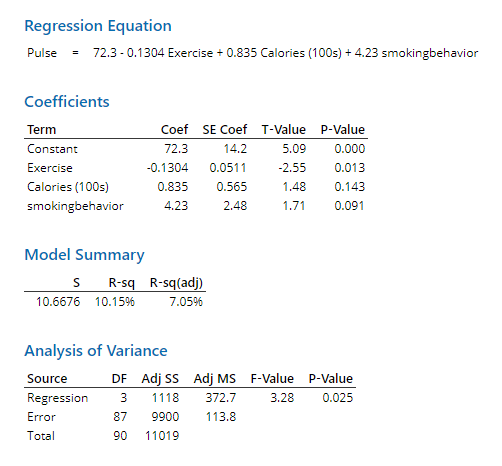Question
part D without VO2MAX(X VARIABLE) The PulseRate.MTW worksheet contains information on average pulse rate, VO2max, weekly exercise minutes, daily calories consumed (in 100s), and smoking
part D without VO2MAX(X VARIABLE)
The PulseRate.MTW worksheet contains information on average pulse rate, VO2max, weekly exercise minutes, daily calories consumed (in 100s), and smoking behavior for a sample of 91 individuals. [Note: VO2max is a measure of your exercise fitness. Higher VO2max levels usually indicate an individual is more fit.] ASSUME ?=.10 FOR THIS PROBLEM!
b)Run a regression model to estimate pulse rate (y-variable) based on VO2max, exercise minutes, calories, and whether an individual smokes (x-variables).
In general, is the overall model significant (use the p-value from the ANOVA table in the MTB output for this)? What about the individual x-variables (VO2, exercise, calories, and smoker)? You will use the p-values associated with each x-variable in the "Coefficients" table in the MTB output to do that. Remember that ?=.10 FOR ALL TESTS IN THIS PROBLEM and remember to click on "Results" and change the "Display of results" option to "Basic tables".
In plain, simple language, what have you learned about pulse rates from this model? Are you surprised? Explain.
c)Generate a correlation matrix (Stat, Basic Statistics, Correlation) using all the variables in your model. I recommend you put Pulse in first and then all your x-variables.
Do you see any signs of potential multicollinearity in the table? Discuss/explain what you should you do in response
d)Now repeat part (b) after removing one of the potentially collinear variables you identified in part (c). [Hint, I recommend you keep the Exercise variable.]
Make sure you not only rerun the regression model with one less x-variable, but also discuss the results of the new model (both statistically and in the context of the problem you're modelling.
e)Finally, do two things using your model from part d:
?Interpret (precisely, in the context of the model) the coefficients on Exercise and Smoker.
?Predict the pulse rate for someone who exercises 130 minutes per week, consumes an average of 2200 calories per day (note that calories are measured in 100s, so you would plug in 22), and is a smoker. Compare your predicted pulse rate to the actual value for person 27 in your sample. How did your model do?

Step by Step Solution
There are 3 Steps involved in it
Step: 1

Get Instant Access to Expert-Tailored Solutions
See step-by-step solutions with expert insights and AI powered tools for academic success
Step: 2

Step: 3

Ace Your Homework with AI
Get the answers you need in no time with our AI-driven, step-by-step assistance
Get Started


